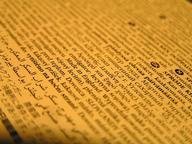Quiz Answer Key and Fun Facts
1. The first written language appeared around 3300 BC and used cuneiform (wedge-shaped) elements instead of the previous pictograms, and writing direction was changed to left-to-right in horizontal rows. Which is that language?
2. The first Semitic language developed around 2500 BC, in the Mesopotamia Region. Which was it?
3. The Egyptian hieroglyphs dating from 3100 BC are signs which could represent anything from a single consonant to a whole word and even "determinatives" that help the reader understand a group of preceding signs. Although very different, they can be considered the source of all Semitic writing systems. Two undeciphered scripts, dated 1800 and 1500 BC, form the evidence for an intermediate script form. In which (modern days) country were they found?
4. English letters have names that do not relate to anything other than the identification of the letter. The Semitic alphabet signs, however, although representing in many cases the same sound, have names with more ramifications. What do these names represent?
5. This alphabet's appearance is registered to the 19th century BC and is predecessor to almost all the Semitic alphabets (and the Thai and Mongol in the East, but that is another quiz). It had 30 elements and the Hebrew alphabet is its closest living descendant. What is the name of this ancient alphabet?
6. The Greek alphabet, the direct predecessor of the Latin alphabet (among others) and consequently of most of the current western world, is actually a 9th century BC close adaptation of an extinct Semitic alphabet. Which alphabet was it?
7. The Greeks did not invent the alphabet, but modified it so as to facilitate its use and consequently its popularity. Which was this welcomed modification?
8. At around the 8th century BC, a new influential Afro-Asiatic language emerged, with scripts found in today's Yemen and Iraq. Curiously, the scripts showed that the language was written in a completely different alphabet than the one actually used today. Which language made this alphabetic switch?
9. In 1000 BC the Hebrew language used the Paleo-Hebrew alphabet, but by 500 BC, during the exile to Babylon, it adopted the alphabet of the language used by most of the Middle East region population at the time. Which language was it?
10. Here is a question about text directionality. Modern Greek is written from left-to-right (dextroverse), while others, such as Arabic and Hebrew, are written right-to-left (sintroverse). The Egyptian hieroglyphs, among other writing systems, are written in the boustrophedon method. What direction is this?
Source: Author
zanazana
This quiz was reviewed by FunTrivia editor
Bruyere before going online.
Any errors found in FunTrivia content are routinely corrected through our feedback system.
